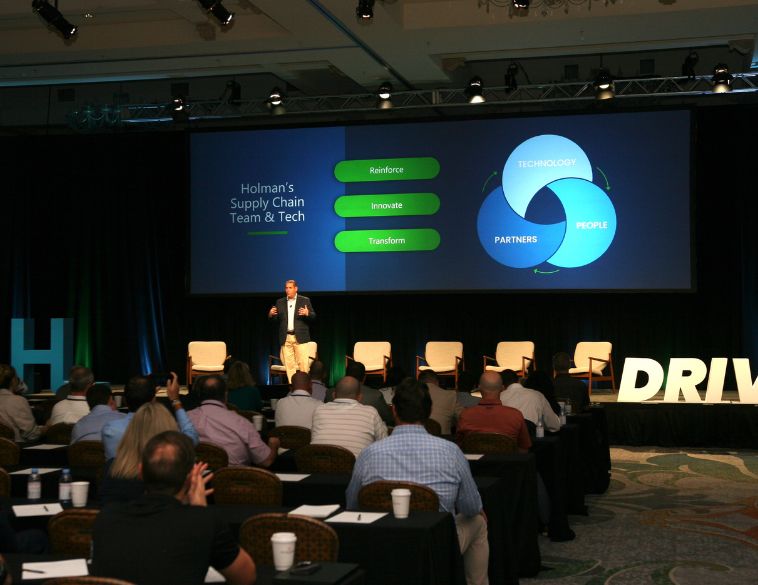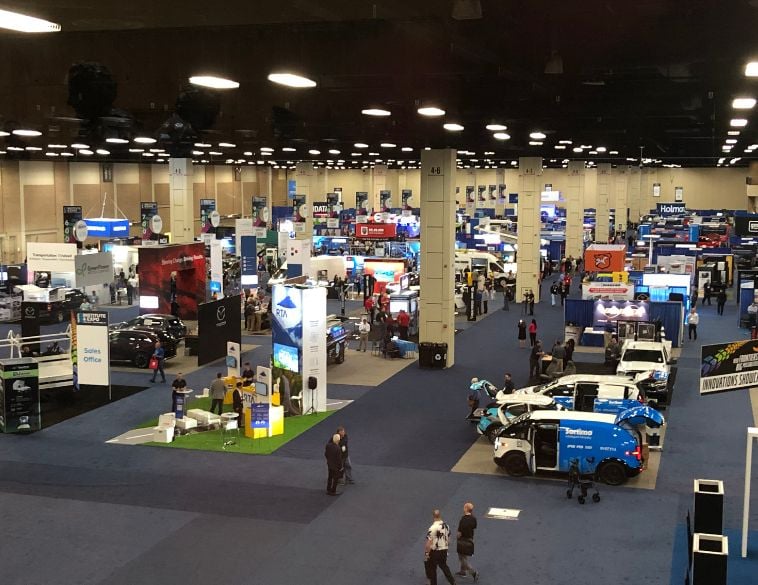In the first of two articles devoted to this industry-leading event, Autosphere looks at some of the key factors influencing the automotive fleet sector today.
From November 6-9, Fleet industry professionals gathered at The Boca Raton Resort, in sunny Boca Raton, Florida, for Holman Drive 2023. This two-day conference, hosted annually, brings together the best and brightest minds in fleet from across Canada and the U.S., providing information and ideas to help move the industry forward.
A core focus
Holman Drive 2023 kicked off with an opening keynote from Chris Conroy, Holman’s Chief Executive Officer. Conroy who was promoted to CEO back in June, has a long and highly successful track record with Holman, having started with the company back in the 1990s. Today, Holman is one of the largest privately managed fleet management companies in the world, and although it does have other interests, including engineering capability, upfitting and automotive retailing, fleet remains a core part of Holman. As Conroy noted “It is our largest business by pretty much every measure that we have in the Holman organization. It is also the one that we believe is set up to guarantee our future success more so than anywhere else.”
Conroy stressed the importance of relationships as fundamental to business growth and by having open and clear communication, and common language and common actions, those relationships and the business built around them can flourish. He also noted the importance of valuing employees, of taking care of them, providing opportunities and empowering them to make decisions, enabling them to grow both personally and professionally and offering them the ability to give back to their communities. “If we do those things,” stated Conroy, “the rest literally does take care of itself.”
In practice this has been witnessed in how Holman has been able to continually bolster its service offerings to its fleet customers, emphasizing the ease of doing business, while at the same time being agile to adapt to the onslaught of disruptions that have, and will continue to impact the automotive and fleet management sectors. Two initiatives are the Holman Strategy Office and Holman Growth Ventures. The first, the Strategy Office, consists of a dedicated team that’s focused on looking at what’s coming over the horizon and creating a strategy and business solutions to help customers navigate and thrive through these upcoming trends and market conditions.
The second initiative, Holman Growth Ventures is designed to grow and develop innovation through investment, including an automotive fund that provides visibility to bleeding-edge technologies such as early-stage start-ups involved in everything from EVs to autonomous vehicles, as well as robotics and digital retailing. Additionally, via Holman Growth Ventures, investments are also being made in organizations that are seen as a strategic fit for Holman, and by extension its customers.
The whole concept is to ensure that Holman is not only there to provide the best possible service to its fleet customers today, but that it is smarter, more relevant and provides the products and solutions necessary for the successful fleets of tomorrow. Conroy also discussed 2024, which represents Holman’s 100th year in business and personally extended an invite to gathered attendees for what promises to be an unforgettable, special anniversary Holman Drive next year.
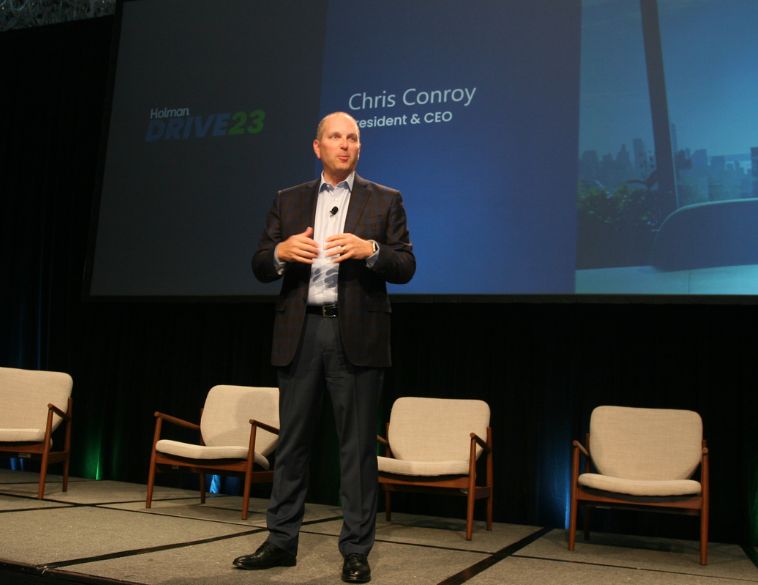
The road ahead
Next up was a highly anticipated panel discussion entitled Roadmap or Roadblock: The Year Ahead for Auto, Fleet & Business. This session focused on some of the major challenges of our time, namely the labour disruptions, supply challenges and government EV mandates that continue to make business unpredictable for many in the fleet segment. Introduced by Ted Davis, Senior Vice President & Chief Operating Officer, Holman Manufacturing and Distribution, the session later expanded to a panel discussion moderated by Kathryn Foster, Director, North American Strategic Services for Holman that included Davis, Pete Dondlinger, President of Holman Manufacturing and Distribution, Jennifer Costabile, General Director of Fleet, General Motors and Michael Taylor, Senior Advisor, Hillstaffers.
Davis talked about the automotive outlook from a pricing, sales and production perspective; the wholesale market in terms of volume and pricing, the impact of the September UAW strikes on the supply chain, and efforts by Holman to integrate the supply chain and provide a better experience for its fleet customers.
Davis noted that overall, 2023 proved to be a fairly solid year for vehicle production and sales, with actual volume outpacing estimates by half to ¾ quarters of a million units, with a run rate prediction of 15.8 million vehicles manufactured and sold in the U.S. About 2.5 million of those are specifically allocated for fleet customers. Looking to 2024, Davis said the outlook is for vehicle sales to stabilize with the prediction of volumes coming in at just under 16 million units for the year, with 3 million or so allocated for fleets. And, while challenges will remain, they are expected to be more of a speed bump than a roadblock.
One factor that will likely aid fleets in 2024 is that vehicle pricing is expected to decline, easing pressure on acquisition costs—around 2.5% according to Davis. Offsetting that however, is the ratification of the UAW contracts among the Detroit-based automakers—Ford, General Motors and Stellantis—where wage increases are likely to be passed on to vehicle purchasers, adding to the operational cost increases many fleets have had to contend with since the beginning of COVID-19.
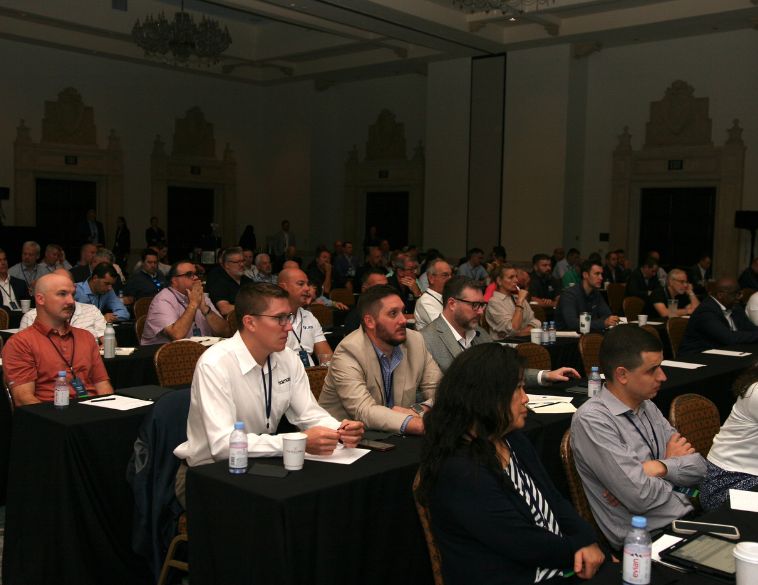
Greater stability?
Nevertheless, if volumes continue to increase as predicted, that could translate into greater price stability and declines over the longer term, which will be welcomed by fleets. Normalized pricing cycles are also expected to continue into 2024 making it easier for fleets to manage purchase and disposal decisions related to assets.
Given that the UAW strikes impacted assembly plants where many key fleet models such as pickups and vans were manufactured, the legacy of the loss of 300,000 or so vehicles from the production line is likely to be felt in the fleet space for some time, in terms of not only vehicle availability, but acquisition costs and lead times, potentially resulting in a sellers’ market, at least into the first few months of 2024. Davis also talked about the integration of the Holman supply chain, which is designed to provide a smooth and seamless process for customers, all the way from engineering, through to up-fit and final delivery of the vehicle—in essence, the one roof, one partner concept that is unique within the fleet management industry.
The panel discussion itself delivered a great deal of thought-provoking and valuable content. Starting out, Jennifer Costabile talked about the challenges fleets have been facing in ordering vehicles and that GM’s approach has been to open order banks and allocate vehicles based on availability. As inventory levels improve and hopefully, the impact of the UAW strikes are mitigated, there is growing optimism that inventories will improve through 2024 and into 2025. Costabile also talked about GM’s approach to zero emissions, and while there has been a lot of development in the BEV space with a raft of new models launching in 2024 and 2025, there is still, very significant investment in internal combustion engine technology, including a new range of small block V8 engines for its full-size pickups, vans and SUVs—meaning GM is planning to stay in the ICE game for a long time.
Michael Taylor provided a hard-hitting view on the California Air Resources Board’s ambitious Advanced Clean Fleet regulations (zero emission vehicle mandates) that are having a major impact on fleets, creating a great deal of uncertainty. Taylor noted that in a nutshell, the biggest issue is that there is a pronounced lack of reality between what the regulations propose and creating a practical, workable solution for transportation. As an advocacy lead for NAFA, Taylor stressed that fleets want a clear and feasible pathway to compliance, which is not the case with ACF.

Highly problematic
Taylor said one of the biggest problems is the fact that government agencies simply cannot mandate innovation by picking an arbitrary date and declaring that by that time, a specific battery-electric chassis technology will be available from the OEMs. “That in itself is inherently problematic,” Taylor said. He noted that a far more feasible approach is for governments to incentivize or encourage technological advancement but ultimately, it will be the market that decides whether it will be implemented and on what scale. There’s also the question of cost since nobody seems to know just how expensive the ACF regulations will be to implement and even CARB has not been able to satisfy their own state department of finance in terms of cost projections for these new regulations.
Infrastructure is also a major obstacle and Taylor noted that as it stands today, certainly in California, the electrical grid is just not ready for mass EV adoption, given that it already suffers from brownouts and blackouts, plus infrastructure data has not been shared with utilities and households.
Additionally, in practice, EVs are often falling short in terms of being able to directly replace ICE vehicles in terms of fleet applications, in some cases it might require two or more EVs to even closely match one existing ICE vehicle, in terms of versatility and operational efficiency and, that is, only if an alternative EV is actually available. This becomes particularly problematic for electric utility and emergency vehicles – if they rely on the grid for charging and the grid goes down, what happens then?
Taylor noted that the real test on EV adoption in the U.S. will likely come in Washington state, which has proposed even more aggressive EV mandates (certainly time-wise) than California (100% EV mandate by 2030).
While the situation regarding the ACF in California and other “progressive” states, including Massachusetts, New Jersey, New York and Washington, is highly problematic and complex, Taylor did note that advocacy efforts are starting to gain traction. He said legislators are listening to the concerns of fleet operators, noting there are problems with the regulations and there is an opportunity for clearer heads to prevail regarding ACF and EV mandates through greater collaboration efforts at the legislative level between government, OEMs and fleets.
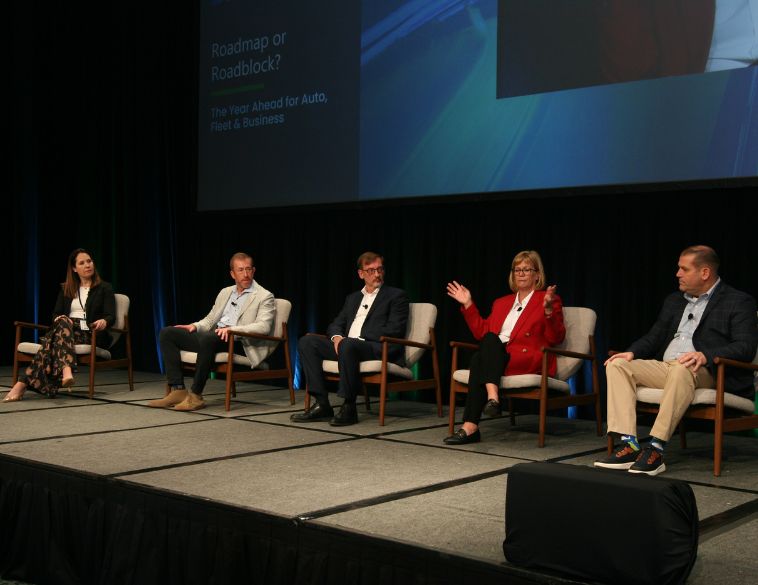
Greater efficiency
Pete Dondlinger discussed the manufacturing aspect of vehicle fleet management, essentially the upfitting engineering and installation that goes into commercial vehicles. Dondlinger noted that the last few years have been “a great learning experience,” namely in being able to improve available inventory at Holman’s Distribution Centers. Additionally, Dondlinger said that Holman’s forecasting data ability has also improved, and along with it the ability to simplify the upfitting order process.
“If you have 300 parts [for upfitting equipment] that go into a vehicle, you configure them in certain ways by working with our engineering teams to come up with solutions,” said Dondlinger. He noted that these parts and equipment can serve a wide range of organizations from HVAC companies to oil and gas companies, to pest control companies etc. He explained that this “configurable approach” is really important in terms of mitigating supply chain risk and overall parts availability.
Given the current economic challenges faced by many fleets, Ted Davis stressed the importance of being proactive with fleet budgets, making sure that money is allocated early and that a significant amount of flexibility is built into that budget. “Jennifer [Costabile] talked about how quickly disruptions can happen,” said Davis, where we might have had plans A and B, now we need plans C and D as well.” He also stressed the importance of being simplistic when it comes to “spec’ing” vehicles—in other words where they are and will be used as well as how. Additionally, Davis explained the importance of solid communication between fleets and their OEM partners, so that the latter are aware of what the fleet is planning in terms of vehicle ordering and deployment in the field, otherwise if they don’t what their fleet customer is planning, that customer is unable to effectively plan and manage their fleet vehicles.
In summing up, there were some key takeaways from the panellists. Pete Dondlinger said that when it comes to fleet partners, working with somebody that has integrated supply chain capabilities is essential in today’s environment, since it will dramatically mitigate the risk of not having the right vehicles in service. On the advocacy side, Michael Taylor said that fleet managers have a critical role in advocacy, particularly when it comes to legislation being drafted in progressive states. Therefore, it is essential to get involved so that associations, fleets and government can work together to achieve beneficial outcomes for all and prevent the adoption of regulations that are detrimental to fleets, the transportation sector and ultimately, the economy. Jennifer Costabile said that from an OEM perspective, it was important for fleets and fleet managers to work with vehicle manufacturers to understand what their short and long-term needs are to ensure success. Ted Davis summarized that a key factor for success in today’s environment is to make sure that as a fleet, you’re resilient, and so is your supply chain. By doing so, he said, fleets can be much more proactive in tackling and even thriving amid potential disruptions on the horizon.
Stay tuned for Part 2 of our Holman Drive 2023 Coverage from Boca Raton, Florida.

